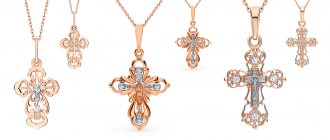Audio version of the article
- History of the Holy Cross K. Parkhomenko
- About the sign of the cross and pectoral crosses Answers to questions
- Holy cross K. Slepinin
- Is it possible to remove a pectoral cross? Deacon Sergius Shalberov
- Truth and myths about the pectoral cross of Rev. Nikolay Markovsky
- Breviary. The rite of blessing the cross to be worn on the chest
- Photo story “Pectoral Cross”
***
A pectoral cross is a small cross that symbolically displays the Cross on which the Lord Jesus Christ was crucified (sometimes with the image of the Crucified One, sometimes without such an image), intended to be constantly worn by an Orthodox Christian as a sign of his faith and fidelity to Christ, belonging to the Orthodox Church, serving as a means for grace-filled protection.
The cross is the greatest Christian shrine, a visible evidence of our redemption. In the service for the Feast of the Exaltation, the Church glorifies the tree of the Cross of the Lord with many praises: “The Cross is the guardian of the entire universe, the beauty of the Church, the power of kings, the affirmation of the faithful, the glory of angels and the plague of demons.”
A pectoral cross is given to a baptized person who becomes a Christian and is constantly worn in the most important place (near the heart) as an image of the Cross of the Lord, an external sign of an Orthodox Christian. This is also done as a reminder that the Cross of Christ is a weapon against fallen spirits, having the power to heal and give life. That is why the Cross of the Lord is called Life-Giving!
He is evidence that a person is a Christian (a follower of Christ and a member of His Church). This is why it is a sin for those who wear a cross for fashion without being a member of the Church. Consciously wearing a cross on the body is a wordless prayer, allowing this cross to demonstrate the true power of the Archetype - the Cross of Christ, which always protects the wearer, even if he does not ask for help, or does not have the opportunity to cross himself.
When performing the sacrament of Baptism, the priest puts a cross on the baby, which from that moment becomes the inseparable companion of the new member of the Church. It is not customary to remove a cross when bathing or changing clothes (in the old days there were even wooden crosses in the baths, which were worn in the steam room instead of their own). Unfortunately, there are also “knowledgeable” advisers: nurses, neighbors, friends who authoritatively convince the mother to remove the cross from the child: they say he is still small, he will get tangled in the ribbon, he will chafe the skin, etc.
There are canonical forms of crosses - four-, six-, eight-pointed; with a semicircle below and others. Each line has a deep symbolic meaning. In Rus', eight-pointed crosses are more common, on the back of which, according to tradition, the inscription “Save and Preserve” is written. Saint Demetrius of Rostov wrote back in the 18th century: “We reverence the Cross of Christ not by the number of trees, not by the number of ends, but by Christ himself, whose Most Holy Blood was stained with Him. Displaying miraculous power, any Cross does not act by itself, but by the power of Christ crucified on it and by invoking His Most Holy Name.”
There are no rules about the material for crosses. Obviously, precious metals are also acceptable here, because for a Christian nothing can be more valuable than a cross - hence the desire to decorate it. But, of course, simple wooden or metal crosses are closer in spirit to the Cross of the Lord. There is also no fundamental difference between a chain and a braid: it is important that the cross is held firmly. The cross should not be removed, incl. during washing and sports activities. Lay people wear a cross (on the body) under their clothes, without deliberately showing it off.
In the first centuries of Russia’s adoption of Christianity, crosses were worn not on the body, but on top of clothing “as clear indicators of Christian baptism.” Later, only bishops had the right to wear a cross over their clothes until the 18th century, and even later – priests. The priestly pectoral cross is called a pectoral cross (“persi” in Church Slavonic means “chest”). Along with the pectoral, priests also wear a pectoral cross.
Russian people swore allegiance on crosses, and by exchanging pectoral crosses, they became cross brothers. When building churches, houses, and bridges, a cross was laid in the foundation. There was a custom to cast many crosses from a broken church bell, which were especially revered. Taking off one's cross or not wearing it has always been understood as apostasy. Over the 2000-year history of Christianity, many people have suffered for their faith, for refusing to renounce Christ and take off their pectoral cross. This feat has been repeated in our time.
There are many superstitions associated with the pectoral cross : if you lose the cross, disaster will happen; a cross lost by someone cannot be picked up; a cross cannot be given as a gift, worn on a chain, and the like. All of them have no basis: you can buy a new cross, wear one that was given or found, and consecrate it in the temple. Those crosses that are sold in the temple are consecrated with a special rite.
***
How to choose a pectoral cross?
A pectoral cross is not a piece of jewelry. No matter how beautiful it may be, no matter what precious metal it is made of, it is first and foremost a visible symbol of the Christian faith.
Orthodox pectoral crosses have a very ancient tradition and therefore are very diverse in appearance, depending on the time and place of manufacture. The traditional Orthodox pectoral cross has an eight-pointed shape.
The veneration of the cross and love for it is manifested in the richness and variety of its decorations. Pectoral crosses have always been distinguished by their diversity both in the choice of material from which they were made - gold, silver, copper, bronze, wood, bone, amber - and in their shape. And therefore, when choosing a cross, you need to pay attention not to the metal from which the cross is made, but to whether the shape of the cross corresponds to Orthodox traditions, which will be discussed below.
Is it worth wearing a cross on your body?
This is an individual decision for each person. There is no mention in the holy book that it should be worn, or that it was worn by the early Christians. But at the same time, there is not a single commandment that would say that wearing it is prohibited. Yes, it used to be believed that wearing such a talisman on the body was a sin and a shame, because it was considered a symbol of the crucifixion, but there is no basis for these statements in the Bible. The fact that it is a talisman and provides protection from the evil eye has not been proven, because according to the legends of Christians, God gives the necessary protection at any time, in any place, and no talismans can influence this.
You can wear such a talisman if a person likes it and understands what it means to bear a cross - a phrase that Jesus Christ once said. And you can believe in God without wearing a talisman on your body. But the symbol can become a source of protection if you believe in God.
How to make a ring as a talisman
How to understand that the glasses are chosen incorrectly?
Is it possible to wear crosses with a Catholic Crucifix?
The iconography of the Orthodox Crucifixion received its final dogmatic justification in 692 in the 82nd rule of the Trull Cathedral, which approved the canon of the iconographic image of the Crucifixion. The main condition of the canon is the combination of historical realism with the realism of Divine Revelation. The figure of the Savior expresses Divine peace and greatness. It is as if it were placed on a cross and the Lord opens His arms to everyone who turns to Him.
In this iconography, the complex dogmatic task of depicting the two natures of Christ - Human and Divine - is artistically solved, showing both the death and the victory of the Savior. Catholics, having abandoned their early views, did not understand and did not accept the rules of the Council of Trull and, accordingly, the symbolic spiritual image of Jesus Christ.
Thus, in the Middle Ages, a new type of Crucifixion emerged, in which the naturalistic features of human suffering and the agony of execution on the cross became predominant: the weight of the body sagging on outstretched arms, the head crowned with a crown of thorns, the crossed feet nailed with one nail (an innovation at the end of the 13th century). The anatomical details of the Catholic depiction, while conveying the veracity of the execution itself, nevertheless hide the main thing - the triumph of the Lord, who defeated death and reveals to us eternal life, and concentrates attention on torment and death. His naturalism has only an external emotional impact, leading to the temptation of comparing our sinful sufferings with the redemptive Passion of Christ. Images of the crucified Savior, similar to Catholic ones, are also found on Orthodox crosses, especially often in the 18th–20th centuries, however, as well as iconographic images of God the Father prohibited by the Stoglavy Cathedral. Naturally, Orthodox piety requires the wearing of an Orthodox cross, and not a Catholic one, which violates the dogmatic foundations of the Christian faith.
Where to buy a pectoral cross?
It is important to contact a trusted company, since this decoration must be durable and wear-resistant. Crosses are rarely changed in a lifetime, and many are of the opinion that this is completely unacceptable. The Golden Age jewelry store offers crosses of different designs, but each product has good performance properties. Before sale, jewelry is checked in the assay office and the Gemology Center of Ukraine.
How to consecrate a pectoral cross?
Traditionally, in the Orthodox Church, the consecration of the pectoral cross is performed by a clergyman in the church. The rite of blessing the cross to be worn on the forehead, i.e. on the chest, contained in the liturgical book - Trebnik.
The cross is consecrated only once. It needs to be reconsecrated only in exceptional conditions (if it was severely damaged and restored again, or fell into your hands, but you do not know whether it was consecrated before).
There is a superstition that when consecrated, the cross acquires magical protective properties. The Church teaches that the sanctification of matter allows us not only spiritually, but also physically - through this sanctified matter - to join the Divine grace that we need for spiritual growth and salvation. But the grace of God does not act unconditionally. A person is required to have a correct spiritual life according to God’s commandments, and it is this spiritual life that makes it possible for God’s grace to have a salutary effect on us, healing us from passions and sins.
Sometimes you hear the opinion that the consecration of crosses is a late tradition and that this has never happened before. To this we can answer that the Gospel, as a book, also once did not exist and there was no Liturgy in its current form. But this does not mean at all that the Church cannot develop forms of worship and church piety. Is it contrary to Christian doctrine to invoke God’s grace on the creation of human hands?
Why don't Orthodox Greeks wear a cross?
Compared to Russia, the Greeks became Christians earlier. But the authorities did not encourage religion, and the Greeks were constantly persecuted, tortured, and crosses were burned if they refused to worship. The opinion has been preserved that if a person professed faith, he wore a symbol of faith around his neck. For example, Procopius. Over time, Christians also began to tattoo crosses on their chests. Please note that Copts still have crosses on their hands.
According to Muslim laws, in the event of an unexpected death, a person has the right to be buried according to Christian customs. Then the population of Greece began to wear medallions depicting the crucifixion. But then they stopped wearing crosses or putting corresponding symbols on their bodies. According to them, during the process of baptism you can already receive a blessing in the form of a protective cross-amulet. At this moment, the person is given the Holy Seal, which looks like a cross. Therefore, according to the Greeks, believers do not need any amulets or paraphernalia on their bodies.
Is it possible to wear two crosses?
The main question is why, for what purpose? If you were given another one, then it is quite possible to reverently keep one of them in a holy corner next to the icons, and wear one constantly. If you bought another one, then wear it...
A Christian is buried with a pectoral cross, so it is not passed on by inheritance. As for wearing a second pectoral cross somehow left behind by a deceased relative, wearing it as a sign of memory of the deceased indicates a misunderstanding of the essence of wearing a cross, which testifies to the Sacrifice of God, and not family relationships.
A pectoral cross is not an ornament or an amulet, but one of the visible evidence of belonging to the Church of Christ, a means of grace-filled protection and a reminder of the Savior’s commandment: If anyone wants to come after Me, deny himself, and take up your cross, and follow Me... (Matthew .16:24).
***
In Rus' they said about an immoral person: “There is no cross on him.”
Pectoral cross: 10 questions about the pectoral cross
Pectoral cross: 10 questions about the pectoral cross
1 WHY SHOULD YOU WEAR A CROSS? – The meaning of wearing a cross is revealed in the words of the Apostle Paul: “I have been crucified with Christ” (Gal. 2:19). The consecrated pectoral cross is a symbol of faith and a sign of belonging to the Church of Christ. The cross protects from evil spirits. Anyone who does not want to wear a cross himself rejects God’s help. Hieromartyr Peter of Damascus said this on the cross: “By the mark of the Honest and Life-giving Cross, demons and various diseases are driven away; and this is done without any expense and without labor. And who can count the praises of the Holy Cross?
2 WHICH CROSS TO CHOOSE – GOLD OR SILVER? – It doesn’t matter what material the cross is made of – there are no rules about the material for crosses. Obviously, precious metals are also acceptable here, because for a Christian nothing can be more valuable than a cross - hence the desire to decorate it. But the main thing is that the cross should be worn without taking it off, and it would be Orthodox and sanctified.
3 IS IT POSSIBLE TO WEAR A CROSS ON A CHAIN? – There is no fundamental difference between a chain and a braid. It is important that the cross holds firmly.
4 IS IT POSSIBLE TO WEAR A CROSS AND A ZODIAC SIGN ON ONE CHAIN? – A pectoral cross is a sign of belonging to the Church of Christ, and zodiac signs, amulets, amulets are evidence of adherence to various superstitions, so you cannot wear them at all. “What does light have in common with darkness? What agreement is there between Christ and Belial? Or what is the complicity of the faithful with the infidel? What is the relationship between the temple of God and idols? For you are the temple of the living God, as God said: I will dwell in them and walk in them; and I will be their God, and they will be My people” (2 Cor. 6:14-16).
5 IS IT POSSIBLE TO WEAR A CROSS WHICH MY SISTER WORN IF SHE BUYED A NEW one? - Can. The cross is a shrine, a symbol of salvation, no matter who wore it.
6 HOW TO DISTINGUISH AN ORTHODOX CROSS FROM A CATHOLIC CROSS? – The Orthodox Church confesses that Christ was crucified not with three, but with four nails. Therefore, on the Orthodox cross the Savior is depicted crucified with four nails, and on the Catholic cross - with three (both legs - with one nail). On the back of Orthodox crosses, according to tradition, the inscription “Save and Preserve” is made.
7 IS IT POSSIBLE TO PICK UP A CROSS FOUND ON THE STREET AND WHAT TO DO WITH IT? – A cross found on the street must be picked up, since it is a shrine, and it should not be trampled under foot. The found cross can be taken to the Church or consecrated and worn (if you don’t have your own), or given to someone who will wear it.
8 IS IT POSSIBLE TO WEAR AN UNCONsecrated CROSS? - Can. St. John Chrysostom writes that demons go around the place where just two sticks (twigs) fell from a tree and lay crosswise. But it’s better to ask a priest to bless the cross.
9 DO YOU NEED TO REMOVE THE CROSS WHEN WASHING IN THE BATH? – It is better to never remove the pectoral cross.
10 IS IT POSSIBLE TO GO TO CHURCH WITHOUT A CROSS?
“Both a temple and a person cannot be without a cross... When a priest consecrates a cross, he reads two special prayers in which he asks the Lord God to pour heavenly power into the cross, and that this cross will preserve not only the soul, but also the body from all enemies, sorcerers, sorcerers, from all evil forces. The cross has enormous power. Not only can you not go to church without a cross; A baptized person should never remove his cross. Even when we wash ourselves, go to the bathhouse, to the X-ray room, to the doctor, we cannot remove the cross.
The cross is a weapon. Whoever has a cross on him, the demons tremble to approach him. That is why it is said in the Easter stichera that “... the cross is the guardian of the universe, the cross is the beauty of the Church, glory to the angels and plague to the demons.” You never need to take off your cross.
Similar
How and why to consecrate a cross
The symbol of faith is only allowed to be worn by sincere believers. If a person does not believe in God, wearing a cross is pointless. Only deeply religious people can receive the protection and help of the Lord with the help of this sign.
To endow an accessory with the required energy and turn it into a Christian symbol, it should be consecrated in a church. Only after this is the product allowed to be worn constantly. It is best to buy a cross in a church shop. All accessories are already consecrated there. In this case, additional rituals will not be required.
If the product was purchased in a store, it must be given to the priest. Then the priest will check the product’s compliance with Christian canons. If everything is in order, the clergyman will step back into the altar and conduct the sacrament of consecration.
The holder of the cross must remain in church all this time and read prayers. After completion of the ceremony, the cross is allowed to be worn.
Compatibility of gold and silver
Muslims generally do not wear rings or chains made of gold for fear of losing virility, but silver, on the contrary, treats inflammatory diseases, protects its owner from the evil eye, damage, curses or love spells.
The compatibility of gold and silver is absolutely excluded on the energy level, since it is equivalent to as if a person driving in a car presses the gas and brake pedal at the same time. The opposite energy flows of gold (Sun) and silver (Moon) not only neutralize each other, they cause whirlwinds, chaos and energy funnels where your life energy will go.
Even if you are skeptical about magic, this does not relieve you of responsibility: by putting on jewelry made of silver and gold at the same time, you run the risk of soon being left broke and even with a “bouquet” of diseases that you didn’t even suspect about before.
Many people are interested in the question of whether it is possible to store gold and silver together, the answer is clear: no! You even need to store them in different boxes or boxes, because otherwise the appearance of both jewelry will deteriorate: silver will quickly turn black, and gold will become dull and lose its power and magical properties.
Women's gold cross
There are several reasons why modern women wear gold crosses. The first of these is belonging to the Catholic or Orthodox religion, while the accessory is a kind of attribute. The second reason is the aesthetic side, because the decoration looks neat and elegant. It doesn’t matter which category you belong to, in any case you should choose the most suitable accessory for yourself.
Modern gold crosses for women are very diverse; every self-respecting brand regularly releases new collections of such jewelry. Those for whom the cross is not only a symbol and an attribute pay maximum attention to its design, but quality also plays a huge role - when purchasing expensive jewelry, it is important to be sure that it is reliable. Therefore, it is worth giving preference to well-known brands that are responsible for the quality of their products.
Golden crosses Sunlight
The Russian jewelry manufacturer Sunlight is known in many countries for its stylish and original modern design of accessories. The catalog of his products includes a large number of body pendants in the form of crosses. The golden cross of Sunlight only from afar resembles an attribute of religion - the design of the products is more stylized as exquisite jewelry.
The Sunlight gold women's cross has a very sophisticated design - miniature products look very fragile and elegant. Most models are decorated with a variety of stones, from budget zirconium to expensive diamond. Some models of crosses are designed in a traditional style - a crucifix is depicted on the bottom, they look just as stylish and sophisticated.
Golden crosses of Sokolov
Beautiful and sophisticated pectoral crosses made of white and yellow gold are produced by the famous Russian brand Sokolov. The main advantage of the brand is the high quality of its products - when purchasing something with a rich decor, you can be sure that it will be worn for a long time without losing its appearance. The design of the products is very stylish and tasteful.
In the Sokolov brand collection you will find the following design options for women's gold crosses:
- cast neat models in a laconic design, with minimal or no decoration;
- gold cross with stones for every taste and budget;
- interesting figured design of crosses;
- crosses with a crucifix in different sizes and designs.
Golden cross Adamas
If you need a high-quality and very stylish body jewelry in the form of a cross, you should pay attention to a manufacturer called Adamas. His collections include a wide variety of models, both in neutral designs and with a pronounced religious theme. The material used is white and yellow gold.
Models of gold crosses are very diverse; this manufacturer can offer you a wide range, which includes the following options:
- laconic form with one miniature pebble, or no decoration at all;
- stylish, sophisticated crosses with a curly ornate shape;
- cut gold women's crosses;
- crosses with crucifix.
The silver of the signs has turned black
An easy way to find out if there is damage or the evil eye is to carefully examine the silver jewelry that you wear regularly. It is this metal that is a sure indicator of a negative impact on your biofield.
Get an answer to the questions: how to find out if there is damage to your health, how to find out if there is damage to loneliness, how to find out if there is damage or the evil eye at home. An article on the “Magistika” website will help you. Why silver turns black on the human body.
Damage or the evil eye manifests itself most clearly if the pectoral cross or paired silver items (earrings, bracelets) have turned black.
Only an experienced magician or psychic who knows how to install protection and also clean jewelry from damage, the evil eye, curses and the crown of celibacy can accurately diagnose the problem. You should seek help from a clairvoyant if you have the main signs of damage: chronic fatigue, recurring dreams, the inability to start a family or conceive a child in the absence of medical problems, a feeling of someone else's presence in the apartment - strange sounds, knocking, rustling and vague shadows that can be seen out of the corner of my eye.
Priests about other people's crosses
People are often interested in whether it is possible to wear someone else's cross. The priests’ answers fit into a few words: “The cross is the cross.” They treat the cross as a shrine, reverently. The prayer “May God rise again” conveys the attitude of a believer to the crucifixion as a living, spiritual being. The clergy do not approve of various kinds of superstitions, predictions, and fortune telling. When asked whether the bad energy and sins of the previous owner will be passed on to someone else’s cross, they remark: “What about virtue? Will it be transmitted too? The priest will advise you to treat the found cross with respect, carefully pick it up and take it for yourself, give it to someone who needs it, or take it to church. But under no circumstances should you step over it or leave it to be trampled underfoot.
Traditions
The history of the formation of Christianity goes back to antiquity. It dates back more than 2000 years. Initially, instead of crosses, it was customary to use medallions with the image of the Lamb of God - a lamb that was sacrificed in order to save people from sins.
At the same time, followers of Jesus Christ always carried with them an image of the crucifixion. It is known that believers began to wear body pendants at the beginning of the fourth century. After the baptism of Rus', this method became widespread.
The symbol of faith was made from different materials - silver, bronze, wood. According to tradition, a body crucifix is put on a person during the sacrament of baptism. At the same time, it is customary to wear it under clothes.











